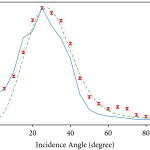Eckdaten
- Zeit: 01/2019 – 03/2023
- An der TU Darmstadt, TEMF, Prof. Boine-Frankenheim
- Teil der Forschung zur Dissertation
- Fokus:
- Particle-In-Cell Simulation (mit smilei)
- Hochleistungsrechnen (auf Virgo)
- KI gestütze Modellierung (mit Keras und Tensorflow)
Ergebnisse
Dieses Projekt resultierte in mehreren Publikationen:
- Ein peer-reviewed Artikel (akzeptiert)
- Datenrepository zur Modellierung von H2O/D2O Targets
- KI Modell zur Vorhersage und Optimierung
BESCHREIBUNG
Das Ziel dieses Projektes ist die Bestimmung eines Surrogat Models für Experimente mit H2O/D2O Liquid Leaf Targets.
Im Rahmen dieses Projektes wurden extensive PIC Simulationen durchgeführt um den Beschleunigungsprozess (TNSA) innerhalb eines Plasmas zu verstehen und die beschleunigten Spektren vor her zu sagen.
Die Simulationen sind von reduzierter Ordnung. Dies bedeutet, dass gewisse Effekte nicht mit berücksichtigt werden können. Entgegen dieser Einschränkung sind gewisse Effekte, wie der von mehreren Teilchenspezies oder Winkelabhängigkeit des einfallenden Laserlichts konnten reproduziert werden.
Aus den Simulationen wurde mit Hilfe von Künstlichen Neuronalen zwei sich gegenseitig unterstützende Surrogatmodelle erzeugt.
Für diese Modelle wurde gezeigt dass Optimierung möglich ist und dass es nicht triviale Optima gibt.
Einige Beispiele sind in der Publikation gegeben.
META
- Time: 01/2019 – 30/2023
- At TU Darmstadt, TEMF, Prof. Boine-Frankenheim
- Part of my PhD research
- Focus:
- Particle-In-Cell Simulations (with smilei)
- High Performance Computing (using Virgo)
- AI supported modeling (using Keras and Tensorflow)
DEliverables
The project resultet in several deliverables:
- A peer-reviewed article which is already accepted for publication
- Datarepsitory for the modelling of H2O/D2O targets
- AI model for the prediction and optimization of experimental parameters
Description
This project aims to determine a surrogate model for experiments with H2O/D2O liquid leaf targets.
The aim of this project is to determine a surrogate model for experiments with H2O/D2O liquid leaf targets.
Within this project extensive PIC simulations were performed to understand the acceleration process (TNSA) within a plasma and to predict the accelerated spectra.
The simulations are of reduced order. This means that certain effects cannot be taken into account. Contrary to this limitation, certain effects, such as that of several particle species or angular dependence of the incident laser light, could be reproduced.
Two mutually supporting surrogate models were generated from the simulations with the aid of artificial neurons.
For these models it was shown that optimization is possible and that there are non-trivial optima.
Some examples are given in the corresponding publication.
Links und Referenzen / Links and References
B. Schmitz, D. Kreuter
Particle In Cell Simulations for a Liquid Leaf Target Experiment
Dataset, corresponding GitlabB. Schmitz, D. Kreuter
Modeling a Liquid Leaf Target Experiment
Modeling Scripts, corresponding Gitlab- B. Schmitz, D. Kreuter, and O. Boine-Frankenheim
Modeling of a Liquid Leaf Target TNSA Experiment using Particle-In-Cell Simulations and Deep Learning
Laser and Particle Beams, vol. 2023, Article ID 2868112, 22 pages, 2023.





